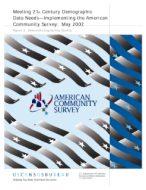
An official website of the United States government
Here’s how you know
Official websites use .gov
A .gov website belongs to an official government organization in the United States.
Secure .gov websites use HTTPS
A lock (
) or https:// means you’ve safely connected to the .gov website. Share sensitive information only on official, secure websites.
-
//
- Census.gov /
- Library /
- Census Working Papers /
- Report 2: Demonstrating Survey Quality
Report 2: Demonstrating Survey Quality
Report 2: Demonstrating Survey Quality
As part of the American Community Survey (ACS) development program, the Census Bureau initiated a research and testing program to examine a range of ACS implementation issues. Key results are being documented in a series of reports. This is the second report. It briefly discusses timeliness and focuses on the accuracy of the Census 2000 Supplementary Survey (C2SS). Future reports will further assess C2SS data quality by comparing responses to questions on the decennial census short and long forms.
The impetus for the development of the ACS was to greatly improve the timeliness of detailed socioeconomic and demographic—decennial census long form—data while maintaining quality. Over the decade, Census 2000 long form data products will continue to age as ACS data products begin providing an ongoing profile of the nation’s people and economy. However, replacing the decennial census long form implies that the ACS must achieve an acceptable level of quality. The expected outcome is that while sampling error will slightly increase, nonsampling error should be decreased when compared to the decennial census long form. Although not exhaustive, this report includes analyses of error levels in the C2SS, and how such error affects the survey’s performance.
Accuracy measures indicate that the C2SS was of high quality, indicating that the ACS will have the quality to replace the decennial census long form, beginning in 2003. Accuracy refers to the closeness between estimated and true (unknown) values. High levels of survey error can lead to incorrect conclusions. Both sampling and nonsampling error can affect accuracy. Sampling error occurs because the survey is using a proportion or sample of the population upon which to draw its inferences. Sampling error is mathematically derived and is, therefore, straightforward to calculate. Nonsampling error includes all other errors including nonresponse, coverage measurement, and processing errors. Nonsampling error is far more difficult to detect and to measure. While the errors herein are depicted as distinct, they are, in fact, overlapping. In developing standards for a large-scale survey like the ACS, designers looked to premier surveys and the decennial census. Where appropriate and when data were available, comparisons were made to the decennial census long form.
Others in Series
Working Paper
Working Paper
Working Paper
Share
Some content on this site is available in several different electronic formats. Some of the files may require a plug-in or additional software to view.
 Yes
Yes
 No
NoComments or suggestions?


Top

